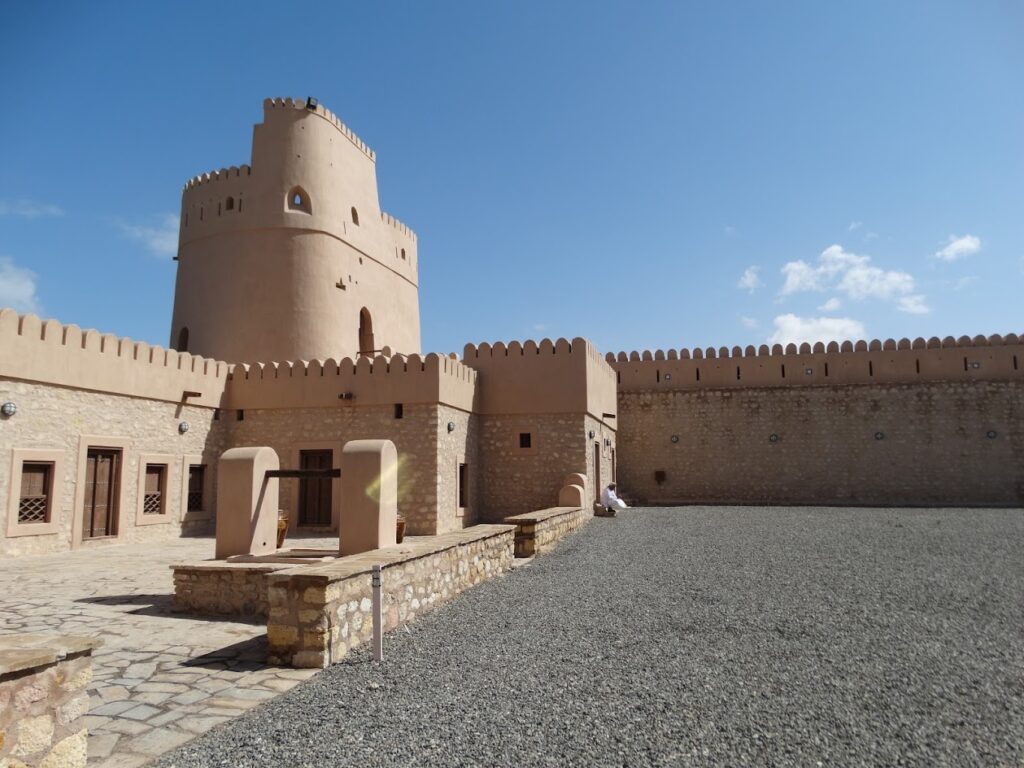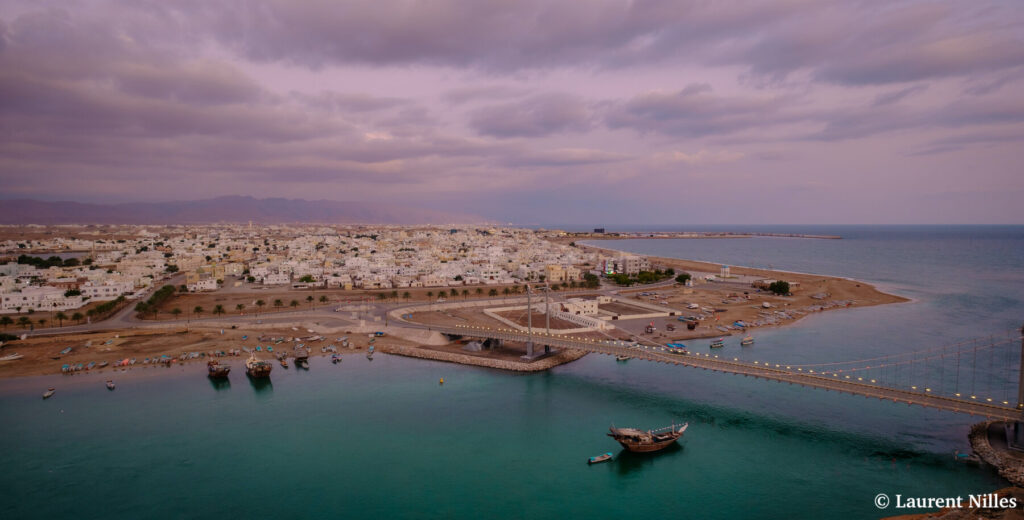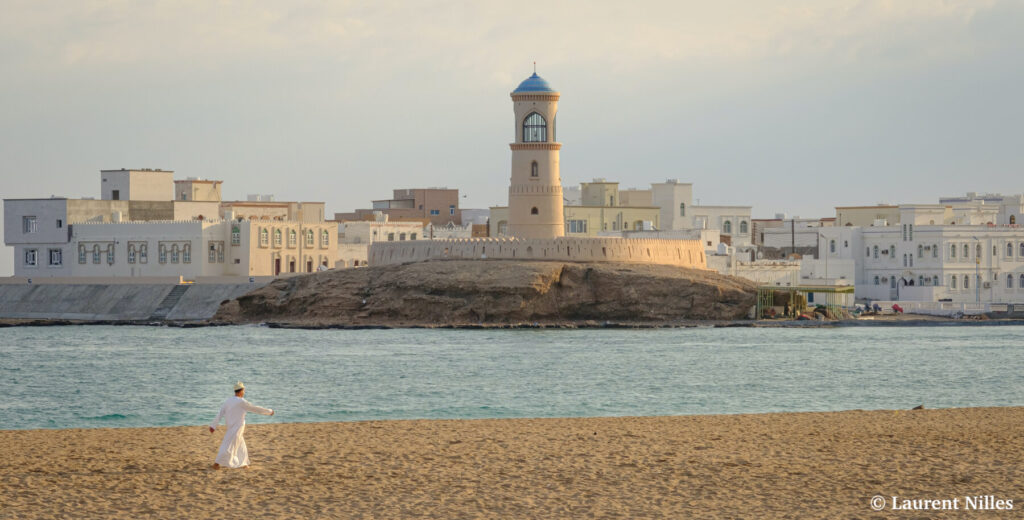Sur is a coastal town that has played a central role in Oman’s overseas trade with East Africa. Like Sohar, Sur is another Omani town that lays claim to being the fictional Sindbad’s birthplace. It shares its Arabic name with the coastal port of Sur in Lebanon, known to Westerners as Tyre, and one attractive theory, based on Herodotus’s account that the Phoenicians came from The Gulf area, is that the Phoenicians originally hailed from Oman’s Sur, then moved on to Lebanon, re-using the name as their hometown.
The modern town of Sur, including its commercial areas, has a sprawl that extends many kilometres inland and it is difficult to establish when you have reached the centre of town. Sur is renowned for its horses, hence the model horse statues that flank the road. The passion for pure Arab thoroughbreds survives here in the form of a few trainers who are masters in their field.
What to see and do in Sur
Bilad Sur Fort
Set well inland in a residential and date garden area, Bilad Sur Fort is recognisable by its unusually shaped tower, with a turret on top – just large enough for a person to stand in and gaze out to sea over the date palms.

The seat of the governor (one of whom was an uncle of Sultan Haitham), this fort dates from the early 19th century and, as with so many coastal forts, was constructed from coral and limestone.
As Sunaysilah Castle
Standing on a mound much closer to the sea and harbour than Bilad Sur Fort, this 350-year-old castle looks far out to sea and provides an excellent view over Sur. It’s a simple design with a square outer wall and round towers. Inside the castle, the entrance hall opens on to a spacious square with only a few rooms, suggesting that the castle was intended for short-term use.
Dhow harbour and Corniche
Sur’s substantial dhow harbour is reached from where Route 23 finishes on a small roundabout almost in the town’s centre. After parking inside you can walk around and should find possibly dozens of dhows and small fishing boats. On the west is Oman Sail’s fishing school and a brightly painted harbour wall with murals by local artists.

Returning the way you drove in and turning left at the T-junction, will take you on to the western end of the Corniche. This is where some fish are unloaded, inexplicably away from the harbour, for sale to individuals or for trucking to Muscat or the UAE. The beach becomes an extensive beach-football pitch in the afternoon.
A walk along the 1.5km Corniche will bring you – via a steel, fish-shaped sculpture full of trash (a copy of an original on Malpe Beach, Karnataka, India) – to Khawr Al Batah Bridge. A restaurant, Al Hawash, overlooks Khawr Al Batah, just north of the bridge. The restaurant offers a good selection of food and, from the outside seating, some great views of Al Ayjah’s old housing on the opposite bank.
South of the Corniche a veritable maze of small streets is packed with housing that leads west into the shopping area and east to Khawr Al Batah Bridge; it makes an intriguing place to explore.
Shipbuilding yards
On the edge of Sur’s lagoon on the Corniche just south of the suspension bridge are the boatyards. The keels and hulls are made from teak imported from India, while the ribs are made from local wood. No plans are ever used: the boats are built by eye, from the outside in, with any and every gap, of which there may be many, plugged by a specifically cut piece of wood.
Though traditional in design and construction, the captain’s quarterdeck for these boats, often destined for Qatar, may be packed full of the latest technology. A small room near the entrance to the yards has souvenirs for sale. Unfortunately, though the site is interesting, there is no information available about the boats at all.
Fatah Al Khair Centre
Set on the edge of Khawr Al Batah the Fatah Al Khair is a sailing dhow that was built in 1951 in Sur and was the last boat of its kind to be constructed. The dhow stands in an open-air plaza, along with other traditional boats, and overlooks Khawr Al Batah. The adjacent building, the Fatah Al Khair Centre, gives an overview of the region’s maritime heritage, through displays of boats, photographs and videos; all information is both in Arabic and English.
The centre has five small halls, which give an introduction to Sur, the town’s maritime legacy with especially fascinating information about 20th-century seafaring captains of the town, details about Fatah Al Khair and other dhows including the fatal last voyage of the Samha, the cultural background of Sur’s maritime history and, finally, Sindbad’s adventures.
Al Ayjah
There are few older houses in Sur today and you will get a better picture of old merchant housing in Al Ayjah, previously a small traditional fishing village but today an increasingly upmarket suburb to Sur.

Late afternoon and early evening are the best times to see Al Ayjah, when the sun sets over the lagoon and casts an ochre tinge over the water and mountains. The old Al Hamuda Fort, once a fort of the Al Hamuda sheikhs from Bani Bu Ali, sits in the centre of this residential area. Its entrance is hidden on the eastern side. Inside, it is very simple and less interesting than the fort in Balid Sur.
After your visit, continue on the tarmac road through the old houses and swing right along the lagoon’s edge towards the new lighthouse which overlooks the bay. In the evening, the town’s youth play football on the sands below. This stretch makes a scenic walk, which from the fort is less than a kilometre. Take the time to stroll about among the houses, especially those that face directly out to open sea away from the sheltered lagoon.
Getting to Sur
There are two routes from Muscat. The coastal Route 17 can be accessed from Wadi Adai in Muscat, or take the Muscat Expressway and exit at junction 5 for Amrat and Sur – these routes then merge and continue as Route 17. This journey is just over 200km. To travel by the inland route, initially take the Muscat Expressway to junction 10B and exit for Nizwa on Route 15. Follow that for about 26km to the junction for Sur on Route 23; Sur is reached about 325km from Muscat.
There are a couple of bus services: bus 36 takes just over 4 hours on the coastal Route 17, while bus 55 travels inland on Route 23 via Ibra and takes around 5 hours; the cost is around OMR4.200 or less. There is a bus office just 200m northwest from the Sur Hotel.